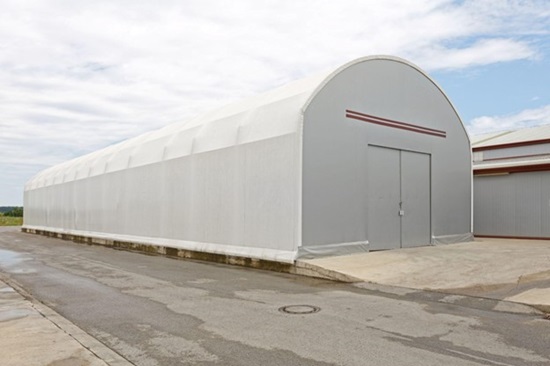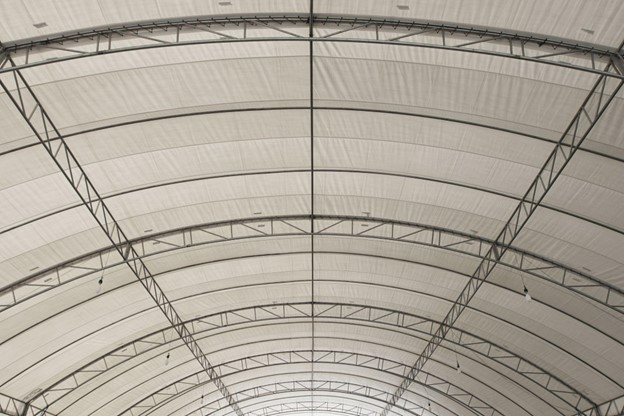 Tuesday, October 15, 2024
Tuesday, October 15, 2024  Tuesday, October 15, 2024
Tuesday, October 15, 2024 
Fabric buildings have emerged as a popular and innovative solution for various industries seeking versatility and affordability without sacrificing quality. These structures have a robust frame, typically made from galvanized steel, which supports a durable, weather-resistant fabric covering designed to withstand environmental elements. In Alberta, where weather can be unpredictable and extreme, fabric buildings provide a reliable option for many businesses. With the ability to customize sizes and layouts, fabric buildings in Alberta are particularly advantageous for adapting to the region’s unique climate and economic demands. Explore the key features, benefits, and longevity of fabric buildings, shedding light on why they are becoming increasingly popular across diverse industries.
Fabric buildings have a robust frame, usually made of galvanized steel, that supports a covering made from durable, weather-resistant fabric. The materials used in these structures are specifically designed to withstand environmental elements, making them suitable for various applications. For example, high-density polyethylene (HDPE) or polyvinyl chloride (PVC) allows for enhanced durability and UV resistance.
These fabric structures can be designed for permanent or temporary use, providing flexibility based on the owner’s requirements. Whether you need a quick installation at a job site, a long-term structure for equipment storage, or even a spacious venue for recreational activities, fabric-covered buildings offer an efficient solution.
Building a fabric structure is often more affordable than constructing traditional buildings, making it an attractive option for many businesses. The materials used in fabric buildings are generally less expensive than those required for conventional construction methods, such as steel or brick, allowing for significant cost savings. Moreover, the construction process for fabric buildings is notably faster due to their lightweight design and simpler assembly techniques. This quick turnaround means businesses can get up and running sooner, effectively reducing downtime and minimizing labour costs during the build phase.
For industries such as agriculture and construction, where time is money, the rapid installation of fabric buildings in Alberta presents a significant advantage that cannot be overstated.
One of the standout features of fabric buildings is their incredible versatility and customization potential. These structures can be tailored to meet the diverse needs of any industry, whether you need a simple storage facility for equipment, a spacious shelter for livestock, or a temporary workshop for a construction project. The customizable nature of fabric structures allows them to come in various sizes and configurations, providing an open interior space free of columns or supports. This flexibility enables businesses to modify the usage of the space as needed, adapting to changing operational requirements without the need for costly renovations.
In Alberta’s dynamic economic landscape, this adaptability can be a game-changer for companies looking to expand, contract, or pivot their business models.
Fabric buildings are celebrated for energy efficiency, becoming increasingly important in today’s environmentally-conscious society. The fabric covering inherent to these structures allows ample natural light to filter through, significantly reducing the need for artificial lighting during daylight hours. This characteristic results in substantial energy cost savings over time, especially for organizations operating large facilities where electricity costs can quickly increase. Furthermore, the insulation properties of fabric-covered buildings help maintain a stable internal temperature, reducing reliance on heating and cooling systems and further enhancing energy efficiency.
For companies seeking to minimize their carbon footprint while maintaining operational efficiency, fabric buildings in Alberta provide an eco-friendly and sustainable alternative to traditional construction methods.
The lifespan of fabric buildings can vary widely, typically 15 to 30 years or longer, depending on several critical factors. Key longevity elements include the materials’ quality, environmental conditions, installation techniques, and ongoing maintenance practices. High-quality fabrics that are UV-resistant and designed to withstand harsh weather conditions, such as those experienced in fabric buildings in Alberta, generally last longer. By employing regular maintenance and ensuring proper installation, owners can significantly extend the life of their fabric-covered buildings, making them durable and cost-effective solutions for various applications.

Fabric buildings are a durable and versatile solution for various industries, ranging from agriculture and industrial storage to recreational facilities. While these fabric structures are built to last, several key factors can influence their lifespan.
The quality of the materials used in fabric buildings is one of the most significant determinants of their longevity. High-quality fabrics, like high-density polyethylene (HDPE) and polyvinyl chloride (PVC), are favoured for their durability and UV-reight resistance. These materials are designed to withstand various environmental stressors, including harsh sunlight, rain, and wind.
Choosing the right materials is essential for ensuring that your fabric building can withstand the test of time and environmental challenges.
Proper installation is foundational to the longevity of any fabric structure. A well-installed fabric building minimizes the risk of issues such as sagging, improper tension, or structural instability. Ensuring expert installation is vital for fabric buildings in Alberta, where the climate can be particularly harsh.
Investing in expert installation pays off in the long run, contributing to the structural integrity and longevity of your fabric building.
Regular maintenance is integral to prolonging the lifespan of **fabric buildings**. Fabric-covered structures benefit from periodic inspections and upkeep to identify minor issues before they become costly repairs. Here are some essential maintenance tasks:
By investing time and effort into regular maintenance, you can significantly extend the service life of your fabric building.
Environmental conditions significantly influence the durability and longevity of fabric buildings. These fabric structures are designed to provide flexible solutions for various applications, but they must withstand the conditions they face throughout their lifespan. In regions like Alberta, where weather can vary dramatically, understanding how environmental factors affect fabric-covered buildings is crucial for ensuring long-term performance.
In Alberta, temperature fluctuations between seasons can be extreme, ranging from hot summers to frigid winters. Such variations can cause materials to expand and contract, potentially leading to stress on the fabric and structural components of a fabric building.
Heavy snowfall is common in Alberta, particularly during the winter months. The cumulative weight of snow and ice can impose significant stress on fabric buildings, potentially damaging if the structure is not designed to handle such loads.
The winds in Alberta can be notoriously strong, particularly in open areas exposed to gusts. Wind can cause the fabric to flap violently against the structure, leading to wear and tear and potentially causing structural instability over time.
Ultraviolet (UV) radiation from the sun can significantly impact the lifespan of fabric buildings. Prolonged exposure to sunlight can lead to fading, degradation, and weakening of the fabric material.
Moisture and humidity are critical aspects that can significantly impact the longevity and effectiveness of fabric buildings. Excessive humidity levels can lead to problems such as mould growth, fabric deterioration, and structural weakening, particularly in fabric buildings in Alberta, where seasonal weather fluctuations are common.
Compared to traditional wood or steel buildings, fabric buildings in Alberta offer several advantages in terms of speed of construction, flexibility, and maintenance. They are typically faster to install and require fewer materials, making them a cost-effective solution for businesses needing temporary or semi-permanent structures.
| Fabric Buildings | Traditional Buildings |
|---|---|
| Quick installation | Longer construction times |
| UV and weather-resistant | Requires extensive upkeep |
| Lower cost | Higher upfront investment |
| Versatile applications | Limited flexibility |
As we’ve discovered, fabric buildings offer much more than a temporary solution; they are a strategic investment for various industries thanks to their robustness, adaptability, and cost-saving benefits. Capable of enduring the tough environmental challenges faced in regions like Alberta, these structures deliver long-term performance that outshines traditional buildings. Whether you need a solution for storage, agriculture, or recreational activities, the benefits of choosing fabric structures are undeniable. Browse an extensive collection of customizable fabric buildings designed for any application. Reach out now to get started on your project and see results sooner than you think!
Check out more news, articles and blogs here